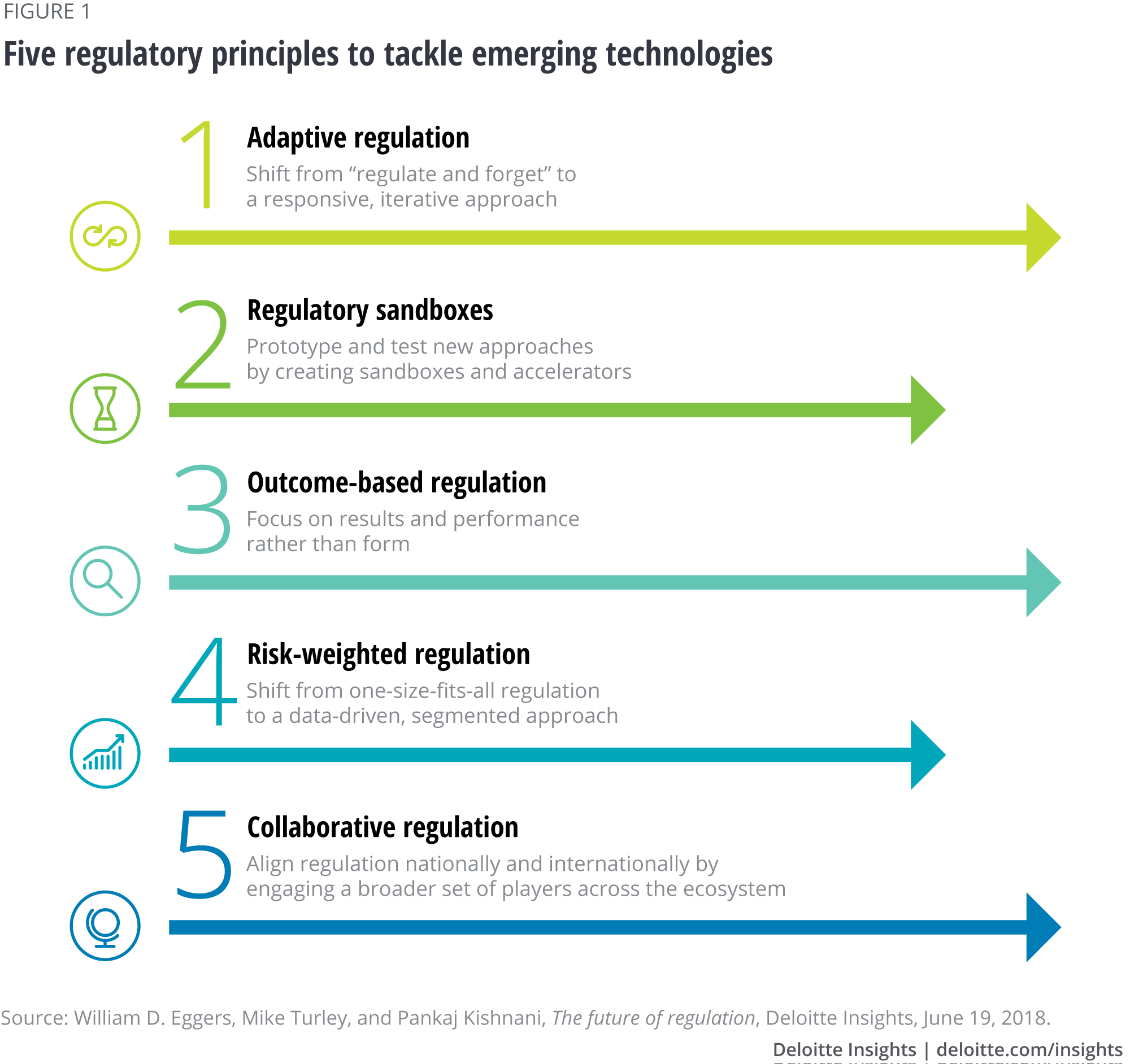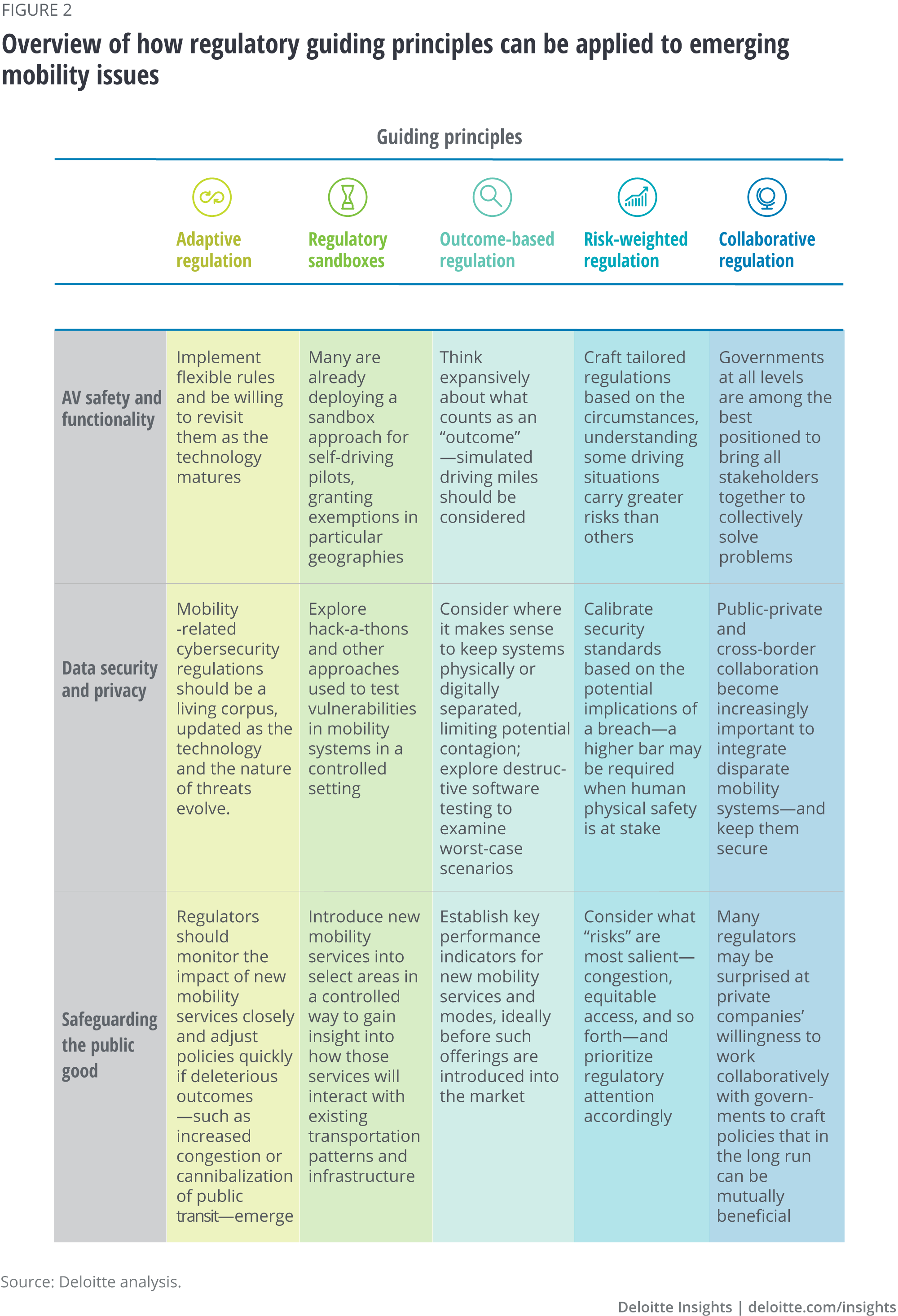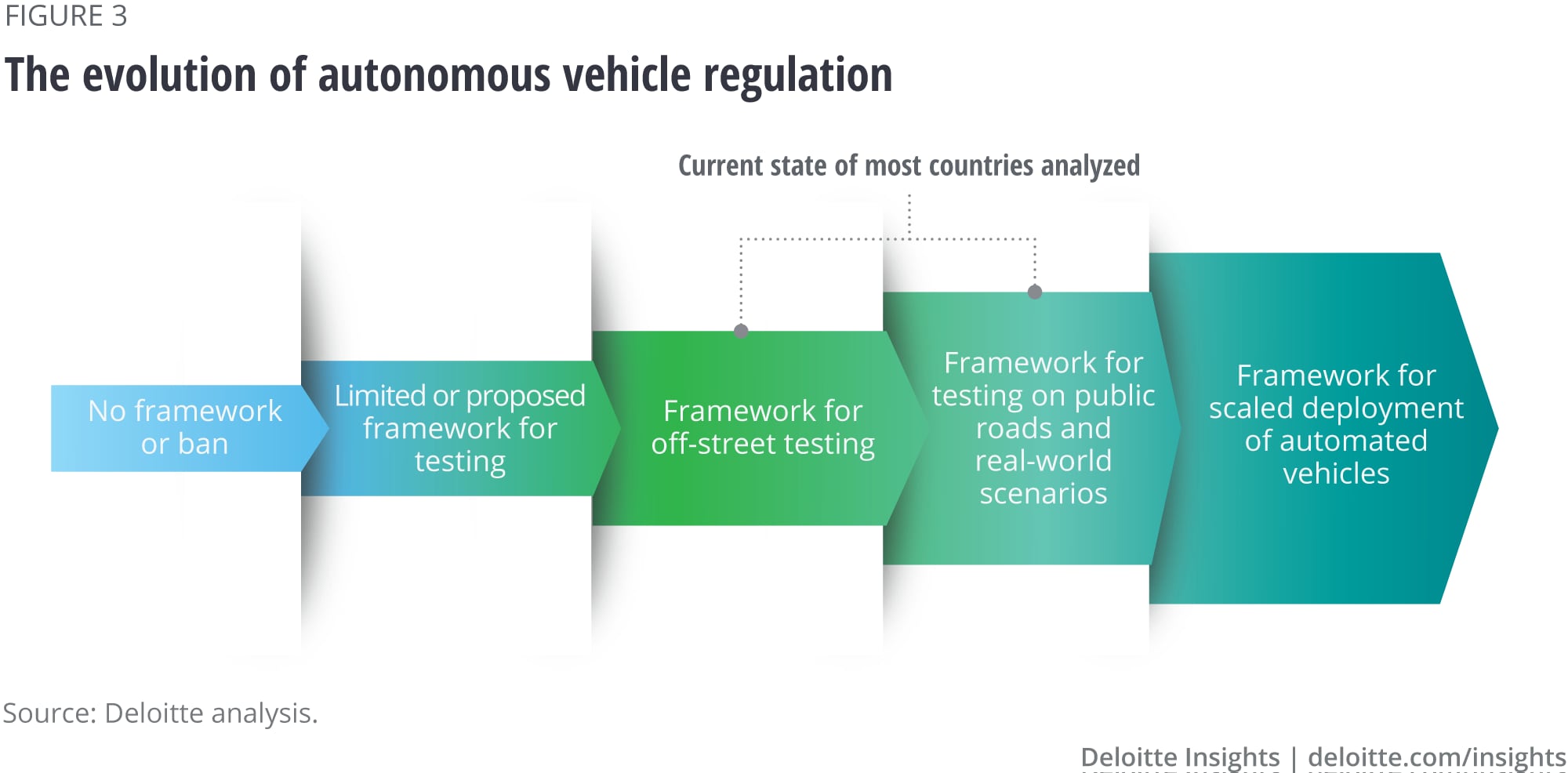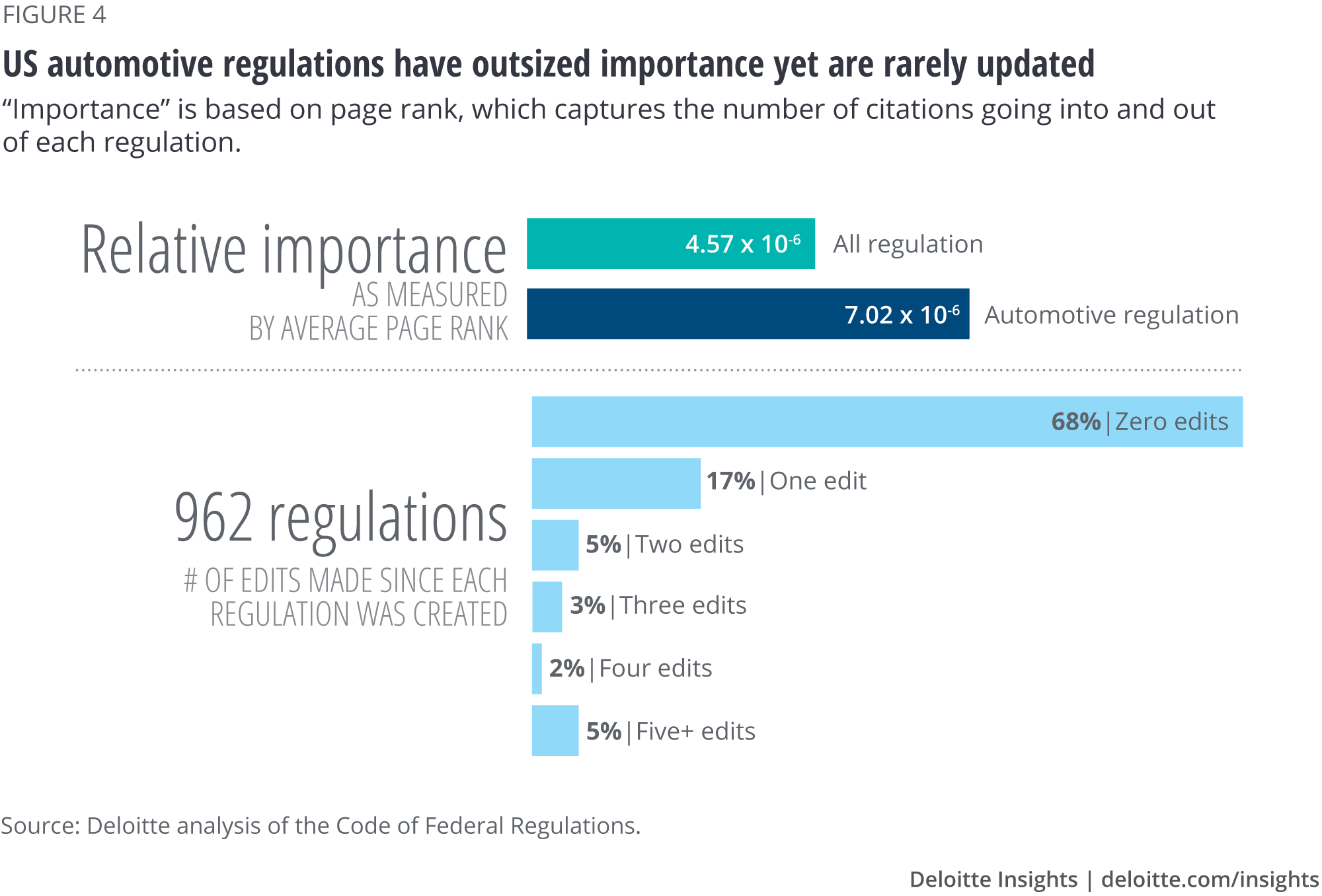
Regulating the future of mobility Balancing innovation and the public good in autonomous vehicles, shared mobility, and beyond
22 minute read
21 December 2018
 Derek Pankratz United States
Derek Pankratz United States Dr. Kellie Nuttall Australia
Dr. Kellie Nuttall Australia William D. Eggers United States
William D. Eggers United States Mike Turley United Kingdom
Mike Turley United Kingdom
The new mobility ecosystem offers the potential for massive benefits—and disruption. Who will ensure that still-unproven technologies improve safety and make people’s lives better? The burden will likely fall on regulators.
Introduction: The public good
Ride-hailing. Bikesharing. Electric vehicles. Self-driving cars. Micro-transit shuttles. E-scooters. Truck platooning. Drone delivery. These developments and more are fueling some of the most disruptive changes in transportation since the invention of the automobile. The result could be a new mobility ecosystem that enables people and goods to move faster, cheaper, cleaner, and safer than today, benefiting individual travelers, governments, businesses, and society at large.
Yet it could also be a world in which unproven technologies worsen, rather than improve, safety. In which congestion increases as people abandon subways for individual robo-taxis. In which communities become transportation deserts. In which some of our most sensitive personal information—where and when and with whom we travel—could be compromised.
Learn more
Explore the Government and public services collection
Read more from the Future of Mobility collection
Delve into the Future of Regulation collection
Subscribe to receive related content from Deloitte Insights
This article is featured in Deloitte Review, issue 24
Download the issue
The onus for preventing these negative outcomes rests with many participants in the mobility sphere, including the companies developing new technologies and services. But regulators and policymakers have a unique, critical role to play. While others may have laudable intentions and strive for societal benefits, it’s government that ultimately has the ability—and responsibility—to safeguard and further the public good.
Regulating the future of mobility is a complex challenge, involving uncertain timing, authorities at multiple levels of government, and a host of issues that extend far beyond a vehicle’s ability to safely navigate city streets. The rapid pace of developments and the idiosyncrasies of any given regulator’s mandate, authority, political constraints, and resources only add to the uncertainty and complexity.
In such an environment, it can be helpful to start with first principles. We have developed five guidelines for regulating emerging technologies (see figure 1),1 and this article applies those guiding principles to some of the core regulatory challenges posed by the future of mobility, including ensuring the safety and functionality of autonomous vehicles (AVs) and other new modes; establishing protocols for safely and securely managing data; and addressing congestion and ensuring access. These principles are not mutually exclusive—indeed, they are often complementary.
Local conditions will, of course, shape any jurisdiction’s specific regulations. As with many of the issues raised by the future of mobility, one size does not fit all. Our intent is not to advocate for more (or less) regulation. Indeed, in some instances, applying our principles may result in a lighter regulatory footprint. Our aim is to offer tools to help regulators approach the complex issues associated with mobility in a way that can help foster innovation, engender economic prosperity, improve safety, and increase access to transportation.

The global regulatory landscape for mobility
A number of regulatory authorities have begun grappling with the challenges posed by the future of mobility. In general, their efforts have been focused on a handful of high-profile, near-term issues: regulating rapidly growing ride-hailing services and creating guidelines for the testing and piloting of AVs.
Shared mobility
Many transportation agencies were caught flat-footed by the rapid emergence of on-demand ride-hailing, which upended cities’ relatively staid taxi and hired car markets seemingly overnight. In New York, ride-hail trips now significantly outnumber taxi trips.2 In London, ridesharing has displaced passengers from buses, leading to lower revenues from fares and raising questions about the levels of subsidy for some routes.3 Reacting to concerns ranging from the treatment of workers to the impact on cab drivers and the potential for increased congestion, national and local regulators have hastened to take steps, ranging from new licensing requirements (London)4 and per-trip fees (Chicago)5 to caps on the number of vehicles (New York)6 and even outright bans on some types of service (Germany).7 As with the broader sharing and gig economies, regulators have had to balance consumer wants, worker welfare, and the interests and innovations of the private sector. And even as they are coming to grips with ride-hailing, new options such as e-scooters and dockless bikesharing have grown dramatically, shifting the mobility landscape once again.8 Too often, regulatory authorities are reacting, rather than proactively defining what mobility goals are a priority and assessing how new technologies might help (or hinder) achieving them.
Autonomous vehicles
To date, developers of AV technology have enjoyed a largely permissive global regulatory environment. With some exceptions, most major economies have placed relatively few restrictions on AV development or testing. The most active governments have created new regulations or modified existing ones to accommodate testing on public roads, clarifying the roles and responsibilities of developers. Singapore, for example, in February 2018 modified its Road Traffic Act, giving the Ministry of Transportation significant authority to regulate where and when AV trials can be conducted, as well as vehicle standards and data reporting requirements.9 In the United Kingdom, the Automated and Electric Vehicle Act provided important clarification about insurance requirements and liability for vehicles operating in autonomous mode, one of the first pieces of legislation to directly address the issue.10
Notwithstanding important cross-national and sub-national differences—with variation in the number of in-vehicle safety drivers required (two, one, or even none), the circumstances and geographies where vehicles can be tested (on public roads versus test tracks), and other conditions—numerous regulators have sought to enable the rapid development of self-driving technology by avoiding extensive or binding rules. Indeed, in the absence of legislation, federal regulators at the US Department of Transportation have opted to issue nonbinding guidance for AV developers (although many states have adopted their own regulations).11 Given recent high-profile incidents involving self-driving vehicles, it remains to be seen how long regulators will continue their light-touch approach. The public, for one, appears open to a more assertive government role: 58 percent of the nearly 1,800 US consumers Deloitte surveyed said the government should exercise “significant oversight” of AV development and use.12
Getting ahead of three key mobility challenges
With some exceptions, regulatory bodies at the national, regional, and local levels have not approached the future of mobility in a way that considers its full range of potential opportunities and impacts. By focusing on today’s challenges—such as coping with fast-growing ride-hailing services or setting the stage for limited AV testing—governments risk missing an opportunity to proactively shape tomorrow’s mobility environment. A more forward-looking and comprehensive approach to new mobility technologies and services informed by data and grounded in a set of underlying principles can help regulators craft guidance that ensures a mobility system that is more efficient, effective, and inclusive. Figure 2 summarizes how the guiding principles for regulating emerging technologies might be applied to three mobility domains.
In this report, we look just over the horizon to consider the broader regulatory considerations for three critical mobility issues: AV safety and functionality, data security and privacy, and managing mobility for the public good.

We have chosen to highlight the most critical guiding principles for each mobility domain. In application, all of the guiding principles have some relevance across each of the mobility domains discussed.
The future of mobility will likely challenge regulators as they seek to balance multiple, potentially competing priorities: fostering innovation and economic growth while ensuring the public good; weighing near-term safety against long-run societal benefits; playing the role of a catalyst, convener, and transit operator in addition to rule maker. Throughout their journey and regardless of the particular issue they are addressing, regulators should keep the following in mind:
Mobility is an interconnected system. Regulators should adopt a systemwide perspective, while operating within the limits of their legal authority and political realities. People and goods move across local and regional jurisdictions and national borders, and technologies are increasingly developed to serve a global customer base. In most cities, residents use a host of different modes—private cars, buses, trains, bikes, pedestrians—that all share critical infrastructure, creating a complex web of interdependencies. Crafting regulations for a single type of transportation or a single geography without a broader systems approach is likely to yield myopic rules that fail to meet users’ needs. Deloitte’s City Mobility Index, which analyzes the transportation landscape in dozens of global cities, finds that such an integrated approach by regulators and transit operators is one of the hallmarks of municipalities with leading mobility networks.13
“Regulation versus innovation” can be a false choice. While overly restrictive rules can hamper private sector activities, regulators should challenge the notion that regulation and innovation are diametrically opposed. Some regulatory handrails, well-implemented, could act as an important catalyst for the development of new forms of mobility. Guidance and rules that cover progressively larger geographic areas can help avoid a hodgepodge of differing and potentially conflicting local regulations.14 Global automakers and technology companies are investing heavily in self-driving cars, electric vehicles, and other new mobility options. Absent clear guidance on the standards those technologies will need to meet, many in the private sector risk wasting potentially billions of dollars on efforts that may ultimately have to be abandoned for failing to meet regulatory approval.15
Trust will fuel the future of mobility. Regulators should aim to foster trust among all parties. Attitudes toward AVs remain inchoate and malleable,16 and deep-seated cognitive biases could limit adoption.17 Shiny new technology in and of itself is unlikely to convince the public of the merits of new forms of transportation. The future of mobility has the potential to address many vexing societal challenges, including congestion, emissions, and uneven access to economic opportunities. But without public trust fostered by customer-focused implementation, players in the new mobility ecosystem could squander a once-in-a-lifetime opportunity to remake for the better one of the fundamental building blocks of modern society. Regulators can play a key role in nurturing that trust.
1. AV safety and functionality
Many regulators have focused on establishing conditions for how, where, and when AVs can be tested and piloted in relatively small numbers, which makes perfect sense given the state of AV development and the reluctance of many to prematurely lock in a particular set of rules. Yet as self-driving technology evolves—multiple companies plan limited commercial launches in the next few years18—regulators will likely need to turn their attention to how these vehicles should operate at scale on public roads (see figure 3).

Key regulatory issues
AVs present a host of thorny potential safety issues for regulators, which may help explain the cautious approach many have taken to date. The foremost concern, of course, is ensuring vehicles are safe for both their passengers and other road users. Yet what constitutes “safe enough,” and how would we know? Should such vehicles be held to the same design and engineering standards as human-driven vehicles, or something more (or less) stringent? How do policymakers weigh the risks that early stage AVs present to today’s users against the potential safety advantages that could accrue to future passengers? Perhaps it’s no wonder that, to our knowledge, no agency has published a detailed set of requirements that AVs must meet to be made available to the general public (in either a personally owned or shared capacity).
Granted, the absence of such standards may not delay the development and deployment of self-driving cars on city streets. In many cases, an AV need only meet the same safety standards (such as crashworthiness) as conventional vehicles. France’s road safety authority has suggested commercially available self-driving cars may simply need to pass a regular driver’s test—a standard that seems to belie the fundamental differences between a sensor- and AI-driven vehicle and a human driver.19 In the absence of formal guidance, numerous companies are pressing ahead with aggressive plans to bring AVs to market in the next several years,20 which makes embracing the new set of guiding principles essential for crafting effective regulation.
Regulatory approaches
Revisit and revise often. Adaptive regulation should form the bedrock of any AV safety protocol. Given the number of variables at play in real-world driving situations, it will likely prove impossible to craft comprehensive and binding rules for AV operation for the foreseeable future. That makes it important to take an iterative, adaptive approach. Historically, this has not been the norm for automotive-related regulations. In the United States, for instance, Title 49, part 500 of the Code of Federal Regulations, which includes the Federal Motor Vehicle Safety Standards and other auto-related items, contains nearly 1,000 rules—two-thirds of which have never been edited. On average, it has been 20 years since any given rule has been created or updated (see figure 4). Adding to the complexity, many of those regulations are essentially “parents” to additional rules, meaning the presence of outdated or obviated rules can cascade through the automotive regulatory framework, creating conflicts or illogical requirements.21

Regulatory approaches: Leading by example
The US Department of Transportation’s Automated Vehicles Policy offers an example of adaptive regulation, rolling out three sets of evolving guidelines in as many years.22 By taking an iterative approach in designing policy for AVs, the department has continued to refine its initial policy of 2017, clarifying most recently that, from a policy perspective, a “driver” need not be a human.23
Focus on outcomes, not process. Focusing on outcomes may allow regulators to sidestep some of the trickiest issues surrounding AV policy—although it may require rethinking what constitutes an “outcome.” For instance, AVs may need to drive hundreds of millions of road miles—even billions of miles, in some scenarios—to establish statistically that they meet certain safety benchmarks24 (counterintuitively, the fewer crashes AVs have, the more miles are required to demonstrate safety). One solution is to factor in both real-world and simulated miles25: Waymo, among the leaders in AV testing, compiled 2.7 billion miles of simulated driving in 2017 alone, more than 300 times its lifetime on-road total.26 While there are limitations to what simulations can accomplish, regulators could work with the private sector and academia to determine how those miles might be factored (perhaps at a discounted rate) into the overall safety record for a self-driving system.
Codevelop standards with key stakeholders. Collaborative regulation will likely be key. Several AV developers have begun creating specific safety standards that aim to provide redundancy in autonomous systems, both for sensors and the decision-making algorithms (whether logic- or learning-based). Mobileye’s Responsibility-Sensitive Safety model, for instance, proposes a foundation for a formal mathematical model of AV safety.27 Building off of and refining these efforts can help regulators ensure that their standards are consistent with industry best practices. Governments at all levels are among the entities best positioned to bring stakeholders together, and gathering their input could be critical to formulating smart, agile regulation.
Harmonize where possible. A patchwork of potentially conflicting regulatory schemes, whether among different states or regions within a country or across international borders, could sow confusion, create additional costs for developers, and slow technological progress. Regulators should look to adopt common standards that ensure interoperability of AV systems across jurisdictions. This is likely to be particularly important in geographies with high degrees of cross-border traffic, whether in the form of interstate commerce in the United States or the movement of people and goods throughout Europe.
Regulatory approaches: Leading by example
With high population density and limited space to expand, Singapore has adopted progressive regulations for the testing of self-driving vehicles; in 2017, the country modified its major road traffic law to accommodate “automated motor vehicles” and “automated systems.” To ensure that regulations remain agile and adaptable to changing technology, existing rules remain in effect for only five years, and the government has the option to revise them even sooner. Lawmakers even made it illegal to interfere with AV testing.28 Critically, further simplifying the regulatory landscape, AV testing falls under a single oversight agency, the Land Transport Authority, avoiding other countries’ patchwork of national, regional, and local rules. The authority has actively partnered with research institutions and the private sector to facilitate pilots of autonomous cars and buses.29
Test-and-learn. Regulatory sandboxes could play an important role, especially in the near to medium term as AV technology matures. Many regulators around the world are already deploying a sandbox approach for self-driving pilots, granting exemptions from some standards in particular geographic areas, and dozens of cities around the world are hosting AV trials.30
Consider relative risk. Testing environments can, in turn, inform a risk-weighted approach to subsequent rule-making, enabling agencies to better understand the degree of difficulty associated with particular driving conditions and “edge” cases, and to craft tailored regulations based on the circumstances. For instance, rush hour at a complex intersection where cars, pedestrians, and cyclists mix might demand a higher safety bar be cleared before AVs are permitted. Data from controlled pilots and regulatory sandboxes can help clarify what situations are most complex and risky.
2. Data security and privacy
Vast and diverse quantities of data underpin AVs and nearly every other significant new mobility technology. The ability to safely and securely collect, share, analyze, and act upon this data is a necessary (if not sufficient) condition for creating a seamless, intermodal mobility system that is faster, cheaper, cleaner, safer, and more accessible than today. Security and privacy loom large in the future of mobility, a fact that most global regulators acknowledge even as they struggle to articulate concrete policies to address it.
Key regulatory issues
The critical role of data in the future of mobility poses a twin set of challenges. The first is to ensure that emerging mobility technologies and services are protected from those with malicious intent.31 There are real and increasing cyber risks associated with autonomous and connected vehicles, vehicle-to-everything communication, and greater connectivity across modes of transport. It’s easy to imagine nightmare scenarios in which entire fleets of AVs are commandeered virtually and used as rolling weapons,32 smart traffic signals are compromised and used to bring city streets to a grinding halt,33 or ransomware prevents your self-driving car from operating until a fee is paid.
Less attention-grabbing but no less important, regulators should also address the safe and permissible use of personal data. As technology increasingly mediates and monitors our movements, AI can more and more easily construct an ever more complete and intimate portrait of our lives. With transportation accessed via an app, mobility providers have the potential to know not only when and to where we commute for work but also with whom we travel on weekends, or whether we have recently visited a hospital or pharmacy. Many of these issues are familiar from the broader conversation about how social-media companies and technology platforms collect and use personal information. But their application to mobility could add additional complexity because of the potential to directly impact not only users’ digital lives but their physical circumstances. Advertising-supported business models have been a staple of the internet age. What happens when an advertiser—recast as a (perhaps hidden) sponsor of a ride-hailing service—can route your trip past its new store, even overriding what your own data suggests would be your preferred option? (See sidebar, “Protecting privacy in a world of seamless intermodal mobility.”)34
Regulatory approaches
Challenge the conventional wisdom about regulatory goals. As with new mobility technologies and services more generally, most regulators are understandably reluctant to issue definitive rules in a field where the nature of the threats is still very much nascent. That makes embracing adaptive, outcome-weighted, and risk-weighted regulation especially important—and can mean reconsidering some of the widely accepted goals of a regulatory framework. For example, many industry participants and observers have lamented and sought to prevent the emergence of a patchwork of standards and systems for autonomous and connected vehicles across different geographies. In the United States, it is one of the most commonly cited reasons for pushing for regulatory or legislative action at the federal level.35
Data security and privacy: Leading by example
In the United States, the National Highway Traffic Safety Administration (NHTSA) convened a public roundtable in January 2016 to facilitate a stakeholder discussion on vehicle cybersecurity topics and to define the agency’s role in overseeing auto cybersecurity. Attendees included representatives of 17 automakers, 25 government entities, and 13 industry associations.36
In Europe, the 15-member European Automobile Manufacturers’ Association in October 2017 published six principles of automobile cybersecurity:
- Cultivating a cybersecurity culture
- Adopting a cybersecurity life cycle for vehicle development
- Assessing security functions through testing phases
- Managing a security update policy
- Providing incident response and recovery
- Improving information-sharing among industry actors37
In February 2018, Israel hosted a smart-cities cybersecurity conference with representatives from a variety of private-sector providers and 80 global municipalities and local authorities,38 providing an important venue to share threat information and best practices.
Several global initiatives are also underway. In 2015, the Automotive Information Sharing and Analysis Center was formed to enhance cybersecurity awareness, share information about threats, and improve coordination across the global auto industry.39 And the Alliance of Automobile Manufacturers and the Association of Global Automakers developed a “Framework for Automotive Cybersecurity Best Practices.”40 The global industry is also extensively engaged with universities and nonprofits to develop and test security protocols.41
Yet such diversity could actually be a boon when it comes to cybersecurity. Multiple AV operating systems or geography-specific digital mobility platforms and mobility-as-a-service applications could improve an overall system’s resiliency and minimize the damage from a cyberattack. Whether by design or happenstance, experts increasingly see the US power grid as benefiting from similar variability and redundancy.42 Because regional grids operate largely independently, the ability for a single attack to create widespread blackouts appears limited.
To be sure, applying a similar approach to mobility systems would come at great opportunity cost because many of the individual, economic, and societal gains associated with new transportation technologies and services are predicated on connecting disparate and disconnected modes and systems.43 But as the nature and severity of cyber risks associated with AVs and other emerging technologies grow clearer, regulators and their private-sector counterparts should at least consider how to create appropriate firewalls—physical and/or digital—to limit the potential harm. An API-based approach that employs secure design and governance principles might be one way to strike a balance between integration and data safety.
Cooperate toward a shared goal. Mobility-related cybersecurity is fertile ground for collaborative regulation, in part because governments and industry want the same thing: safe, secure transportation. Thankfully, many global regulators have embraced that collaborative approach, fostering industry-led standards-setting and reporting bodies. Some organizations have looked to codesign regulations and guidelines as a way to quickly establish frameworks for industries to follow. Public-private collaboration has—and should—cut across jurisdictions and borders as well. Government agencies can also support and take cues from the numerous industry-led groups that have sought to address cyber risk in autonomous and connected vehicles.
Protecting privacy in a world of seamless intermodal mobility
Unlike with risks stemming from malicious actors or cyberattacks, when it comes to safeguarding consumer privacy, the interests of governments and the private sector may not be aligned, suggesting possible limits to an industry-led, collaborative regulatory approach. Privacy issues are hardly unique to mobility, however. In many cases, it often makes sense for relevant regulators to consider the evolving set of regulations and soft law emerging from broader discussions about how organizations and agencies collect and use personal data (the General Data Protection Regulation in Europe or the California Consumer Privacy Act, for example). That said, it will be important for regulators to factor in the additional considerations unique to mobility. That can include the ability to track a person’s movement (although smartphone-generated data already can provide a granular picture of our day-to-day travels), but also the ability to potentially affect a person’s physical (versus digital) experience—which may demand additional levels of protection, or at least transparency about what data is being collected and what the consumer receives in return (a discounted fare, for example).
At the same time, regulators should foster data-sharing across private-sector providers, which can be the linchpin for creating integrated systemwide optimization that could truly address societal ills such as congestion. It will likely be important to establish data-sharing protocols that include wide use of anonymization and careful consideration of which data fields are shared across entities. In addition to protecting individual privacy, both measures can help alleviate private-sector operators’ fears that by sharing data they could be surrendering a key source of differentiation and value creation.
3. Managing mobility for the public good
The future of mobility offers tremendous promise: a world of seamless, intermodal transportation that meets all users’ needs.44 Self-driving vehicles and shared mobility could provide transportation to many millions of people who currently struggle to get around, especially the young, the old, and the disabled. They could be key to helping the roughly 15 million people in the United States who report having difficulty accessing transportation,45 and widespread AV deployment could enable 2 million job opportunities for the US disabled community alone.46 Energy think-tank SAFE forecasts the total annual benefit of AVs to American consumers and society reaching nearly US$800 billion by 2050.47 Yet there are darker versions of this future.
Key regulatory issues
If ride-hailing and AVs offer more convenient and potentially less-expensive travel, miles traveled could increase, potentially exacerbating congestion and pollution.48 While the research on ride-hailing’s impact is mixed, with some studies suggesting ridesharing could significantly reduce the number of for-hire vehicles required to meet demand,49 research indicates transportation network companies’ services have already added 5.7 billion miles of driving in the nine largest US cities.50 If commutes become less onerous, people may be willing to live farther from their jobs, potentially contributing to sprawl and the “hollowing out” of urban cores.51 Likewise, ubiquitous and inexpensive shared AVs could cannibalize public transportation—still the most efficient means of moving people in cities52—exacerbating the funding and infrastructure challenges that transit operators face. In New York, for example, 50 percent of ride-hail trips would have otherwise been made using transit, according to the city’s surveys.53 Discriminatory levels of service, which academic research suggests are already a challenge for ride-hailing in some locations,54 could become both more subtle and more difficult to root out if passenger pickup decisions are increasingly made by artificial intelligence. Such “algorithmic bias” can be notoriously tricky to identify and correct.55 None of these negative outcomes is certain. But it could fall to regulators, working with private-sector partners, to help prevent their emergence.
Regulatory approaches
Introduce innovations with a systems perspective in a measured way, and carefully track impact. Regulatory sandboxes can be an important tool in that effort, especially in cities. Transportation systems are often highly complex, with difficult-to-perceive dependencies across modes. Changes—from introducing a new fleet of shared self-driving cars to something more prosaic such as adjusting subway signaling—can create unanticipated and unwanted ripple effects.56 Authorities should start with a system mindset that considers the entire transportation network, focused on the mobility challenges they are trying to solve. While deploying the latest app or mode of transport can be tempting, resist doing so for its own sake. Then, by introducing new mobility services into select areas in a controlled way, regulators and companies can gain critical insight about how those services interact with existing transportation patterns and infrastructure. This is the approach being adopted by many global cities currently hosting AV pilots—and has decidedly not been the experience of many cities that have experienced an influx of dockless scooters.57
Managing mobility for the public good: Leading by example
Finland is a pioneer in enabling integrated, multimodal mobility. Through a process of “de- and re-regulation,” officials streamlined and simplified the policy framework (by, for example, removing the distinction between traditional taxis and ride-hailing services) while also adding new data sharing requirements for mobility service providers.58 This has enabled mobility-as-a-service provider MaaS Global to incorporate public transit data for the city of Helsinki to create an app that allows users to access multiple modes of transport on demand, with a goal of reducing private car ownership, emissions, and congestion.59
Establish key metrics based on citizens’ priorities and govern new mobility options accordingly. An outcome-based approach to regulation can be integral to successfully deploying regulatory sandboxes, and to mitigating unwanted unintended effects more generally. As new mobility solutions are introduced, regulators should monitor their impact closely and adjust policies quickly if deleterious outcomes emerge. For many, this also could require a new set of capabilities, such as deep expertise in mobility technologies; the ability to collect, manage, and analyze large quantities of low-latency data; and the cultivation of strong, trust-based relationships with a multitude of stakeholders.
Consider new policy tools to affect results. One manifestation of an outcome-focused approach has been the deployment of usage-based charging.60 Many countries have experience with tolling in some form, and more recently governments have explored congestion charging schemes—a fee associated with entering a particular area, typically a city center—as seen in London, Singapore, and Stockholm.61 But policymakers could look to establish truly dynamic user-based charging systems that can adjust prices in real time based on an array of conditions. Such a system could provide transport managers with a flexible and adaptable tool that can be used to influence behavior and help manage demand by adjusting pricing to encourage people to drive at different times or on different roadways. It can also be used to shift usage to different modes of transport: As the cost of driving a personal vehicle alone rises, people may switch to public transport, carpooling, or cycling. And more dynamic pricing can extend beyond roads to include curbsides, with many cities revisiting their curb management plans.62
New technology and detailed, dynamic maps of when an area can be designated for, say, delivery vehicles and when it should be reserved for, say, buses are the first steps toward differentially charging users for their use of that space.63 The most encompassing version could manifest as a citywide integrated mobility platform that brings together physical infrastructure (roads, rails), modes of transport (cars, public transit, ridesharing, bikesharing), and transportation service providers (aggregators, public transport system) and creates optimization systemwide through market-clearing mechanisms.64 All of which would be predicated on governments utilizing more accurate, comprehensive, and lower-latency data.
Managing mobility for the public good: Leading by example
In the United States, Boston deliberately expanded its AV test area to include South Station, a major commuter rail hub, to examine AVs’ impact on public transit.65 Off-street testing facilities, such as those at Singapore’s Nanyang Technological University and Michigan’s MCity and American Center for Mobility, and sophisticated simulators can also provide critical insight.66
Collaborate early, when and where possible. Crafting collaborative regulation may be one of the more difficult challenges agencies face when attempting to address the negative second-order effects of new mobility technologies. In some instances, the goals of the public sector and various private-sector entities may be at odds. For instance, automakers’ core business is selling cars, not encouraging people to use public transportation or optimizing a city’s overall transportation network. And if a shared AV ride-hailing service is supported by in-vehicle advertising content, the operator’s incentive would be to extend the trip and to make more of them, driving up miles traveled—and potentially exacerbating congestion and pollution.67
Managing mobility for the public good: Leading by example
Ridesharing companies have worked with multiple public transportation agencies to serve as a first-mile/last-mile solution to get people to and from mass transit stops.68
That said, many regulators may be surprised by private companies’ willingness to work collaboratively with governments to craft policies that in the long run can be mutually beneficial. Uber and Lyft have both expressed support for broad-based congestion pricing on private vehicles.69 Cooperation will vary by geography and issue, of course, and not all mobility providers have proven to be attuned to public-sector concerns. Regulators would do well to adopt the old mantra of “trust, but verify.”
Destination: A better place
The new mobility ecosystem has the potential to transform daily life for millions of people and countless businesses. And every player shares responsibility for making that transformation beneficial rather than detrimental. But policymakers and regulators have a particularly critical role in furthering communication and coordination, setting standards, and ensuring new transportation modes don’t worsen congestion or leave low-income people stranded. Regulators and other public authorities are particularly well-positioned to act as catalysts and conveners to shape the emerging mobility ecosystem. Companies may insist they want to make the world a better place for everyone,70 but that’s government’s actual job.
In this case, that job is hardly an easy one, with a wide range of public- and private-sector entities looking for mobility opportunities and an even wider range of citizens likely to see real-life impacts on how they travel. The level of uncertainty is high, particularly as the future of mobility involves self-driving vehicles: No one knows for certain when, where, and how we’ll see autonomous cars on city streets. But agencies shouldn’t wait for technology to get to the next level: Regulators should step up and get involved in crafting policies and establishing protocols, preferably in collaboration with companies working to create the new mobility system’s hardware and software. There’s a real chance to get it right for everyone.
Explore the Future of Mobility
-
Future of Mobility Collection
-
Forces of change: The future of mobility Article6 years ago
-
Psychological barriers to the elevated future of mobility Article5 years ago
-
Seleta Reynolds aims to bring 21st-century mobility to a city built for cars Article6 years ago










